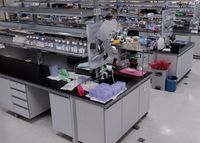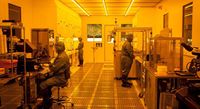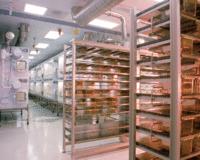The Empiricalum is the headquarters for researchers in House Shar Dakhan. Constructed in mid 34 ABY under the orders of the then acting Quaestor, Darkblade hoped to foster the brilliant minds within the House and give them the opportunity to broaden their horizons. Aul Celsus later joined the construction efforts, giving his advice on layout and design of the facility.
History
After the Dominion attack on Aeotheran during Operation:Homeland, Darkblade ordered the construction of a research lab in 34 ABY. Here the members of House Shar Dakhan could conduct their experiments in an environment that would be relatively safe. The research facility consists of a ground floor, and an underground floor, which is used for the testing of concoctions on live subjects. There are several holding cells contained underground, which are used to hold prisoners who need to be kept "safe". There is also a special chamber, whos access is limited to the Quaestor of Shar Dakhan and the Mayor, Arik Shathis. Darkblade uses this chamber to perfect his torturing techniques, and to keep some prisoners a secret from the Clan.
Facilities
 Floorplan of The Empiricalum
Floorplan of The Empiricalum
The subterranean facilities of The Empiricalum maximize security of both the personnel above the facilities from the experiments being performed, as well as protecting the experiments from perturbation, contamination and critique by unauthorized personnel.
The Empiricalum is accessed via biometric security access, with all authorized personnel subject to cataloging of various biological specimens including blood, hair and skin biopsy. All-hour security is positioned at the main entrance to the facility as well as an automated weapons bank pointed at the primary entrance in case of a coordinated break-in, or break-out.
The Empiricalum is constructed out of half meter thick durasteel beams. The interior surfaces are polished marble and duracrete. The interior hallways are etched with intricate designs of ancient Sith scrawlings.
Molecular Biology Lab (MolBio)
 MolBio lab
MolBio lab
The molecular biology (MolBio) infrastructure is composed of 15 double-wide benches, capable of hosting 20 active research spaces while the remainder contain various benchtop equipment. The MolBio lab contains necessary equipment to perform nucleic acid and proteomic experiments, including but not limited to DNA/RNA sequencing, gene and peptide synthesis, in vitro experimentation, super-resolution fluorescence microscopy and various biochemical assays.
A positive-pressure preparation room is housed within the MolBio facilities meant for ultra high sensitivity experiments that are readily susceptible to airborne contamination. These experiments may include isolation of ancient DNA and preparation of highly sensitive toxins/poisons. The preparation room contains a biosafety containment hood for quick use of laminar flow isolation in order to isolate samples and experiments from contaminants.
Synthetic Chemistry Lab (SynChem)
 SynChem Lab
SynChem Lab
The synthetic chemistry (SynChem) infrastructure is composed of 4 double-wide benches and a maximum face-velocity chemical fume hoods and a glovebox. The SynChem lab contains the necessary equipment to perform experiments involved in novel substance isolation and chemical sensor development, as well as supplemental experiments for the MolBio lab such as purifying toxins or modifying biological chemicals such as proteins, lipids and nucleic acids. The lighting of the room is yellow-filtered in order to avoid destruction of photo-sensitive chemicals by UV and near-IR light.
The attached stockroom has capacity to store over 2000 bottles, jars and ampoules of chemicals and reagents for experimentation in the SynChem and MolBio labs, including separate containment for acids, bases, flammables and oxidizers.
High Containment Lab (HiCon)
 HiCon Lab
HiCon Lab
The Negative-Pressure High Containment (HiCon) facilities are meant for the most dangerous of Empiricalum experiments. These experiments involve pathogens, toxins and other chemicals that would either instantly kill the researcher, or would otherwise fatally contaminate or infect them without hope for treatment. The lab contains a number of "bunny suits" for use by the researchers at all times, requiring that they go through a separate chamber before entering the room in order to don the protective garments. Because of the difficulty in getting into and out of the HiCon lab, most researchers will spend upwards of 6-8 hours at a time in order to avoid having to decontaminate themselves for each exit. The HiCon lab is kept under a strict negative-pressure environment in order to avoid accidental escape of any contained materials that would put other researchers, or the populace at-large, at risk.
Temperature Controlled Labs (ColdLab and WarmLab)
Two temperature-controlled labs kept at 4 degrees centigrade (ColdLab) and 37 degrees centigrade (WarmLab) are maintained for experiments which require absolute and constant maintenance of temperatures, such as enzyme-labile experiments (ColdLab) or in vivo experiments with live animals (WarmLab).
The Vivarium (VIVA)
 The VIVA
The VIVA
The Vivarium (VIVA) houses subjects used for live experimentation. Specific sections of the VIVA are isolate for organization of specimen type, such as mammalian, reptilian and aquatic subjects. Entering the VIVA requires passage through an antechamber that contains specific garb for researchers to protect themselves and the contained subjects from unnecessary exposure to contaminants and irritants.
Each housing section is customizable depending on the size of the subject. Rodents and other small mammals are housed in groups of 5-6, for example, while larger subjects such as primates and other associated large animals are generally housed singly. Larger, more expensive or otherwise important subjects are kept towards the front section of the VIVA. Because of the configurability of the VIVA modules, the maximum capacity of the facility is variable. However, as an example, if only rodents were housed in the facility the maximum capacity would be over 30,000.